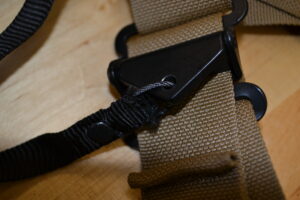“Discovering the unexpected is more important than confirming the known.” George E. P. Box
My last NRA Show report mentioned a new sling design manufactured by McLean Industries, and that I’d follow up on it after I had some time for testing.
I’ve spent around 100 range hours with McLean and the short story is: I love it!
The official name from McLean is the Dynamic Retention Rifle Sling, which, at first glance, appears to be a standard 2-point sling. However, the difference is that there’s an additional small loop at the forward attachment point that when pulled instantly turns the two-point into a single point.
When switching shoulders for a support side shot, standard two-point slings leave operators with little option than to climb out of the sling. Many 2-point slings (like the Blue Force Gear Vicker’s) have sliding buckles which can be rapidly manipulated to add slack, but, as is often the case, it’s not enough length to move the rifle to the support side while remaining in the normal carry orientation. This is especially true of the larger framed shooters and those wearing armor. Of course, once one is “un-slung” the question becomes: when in this fight are we planning on re-slinging? Weapons retention, in both hands-on fighting and utility actions (climbing, dragging wounded, applying first aid, etc…), is now at risk once we separate ourselves from our rifles.
McLean has a solution.
Giving the loop a quick yank opens a hinged hook and releases it from the forward mounting loop – this allows for quick reorientation of the rifle to the support side while leaving the sling in place, now as a single point.
Brilliant!
Pinching the hinged hook opens it for reattachment to the forward loop. With some practice, it takes about a second. I have NOT had it “accidentally” open at any time, thus far, I’m sure the loop could catch on something and cause that to happen, but even then, you’re still attached to your rifle.
The McLean is also equipped with the sliding buckle, much like the Vicker’s and Magpul. The primary reason “tactical” slings possess that feature is to allow for the sling to be left long so the operator can climb into it easier and then cinch it up quickly. It also allows for different adjustments for gear and clothing changes without having to pull double loops of sling material through standard sling buckles, which is a tedious task.
On that subject, a student in last week’s Level II Rifle program lost control of their rifle because a flimsy, plastic sling buckle broke, releasing the tail of the sling through the mount and dropping his rifle to the ground [like the anchor of a container ship in dry dock!]
Field modifications were adapted [Duct Tape] in order to continue on, but a new, proper sling was ordered before the end of class.
One modification I would prefer on the McLean would be to have the sling ends folded and sewn in place. This acts as an additional buffer against the sling tab inadvertently slipping through the buckle. And, yes, the ends can still be fed through or removed from the buckles, but it requires a different threading angle to achieve.
Hardware on serious gun slings should be steel, aluminum, or a robust polymer, like that produced by Magpul. The cheap, plastic-equipped “Uncle Mike’s” nylon slings, and the rest of those found in the Bass Pro hunting section, should be ignored with prejudice!
My present sling recommendations are the McLean, Vicker’s, and Magpul. I’m sure there are others, but those are the three I’ve run hard enough to be sure of.
When ordering the McLean, they offer a package deal that includes a Sylvan Arms front QD mount. It’s best when using their rapid disconnect function to have a NON-swiveling front ring attachment point as attempting to re-connect the sling can be a task since you end up wrestling with a moving target. The Sylvan looks like a good option, and I’ll be ordering one to try out.
Final Note:
All rifles need a sling! In fact, all rifles need a sling and a spare. Those who don’t train regularly may not understand that, but, like magazines, slings are a consumable item. They get damaged, broken, loaned out, and lost. Have multiple copies.
Quality slings will run from $50-100, and they’re worth every penny.
“A fool with a tool is still a fool” – Grady Booch









